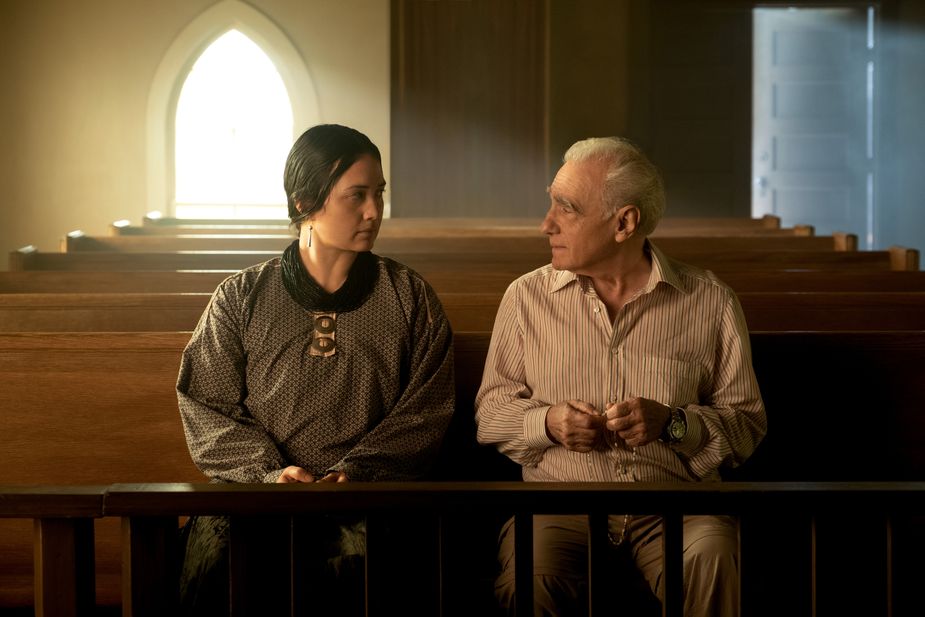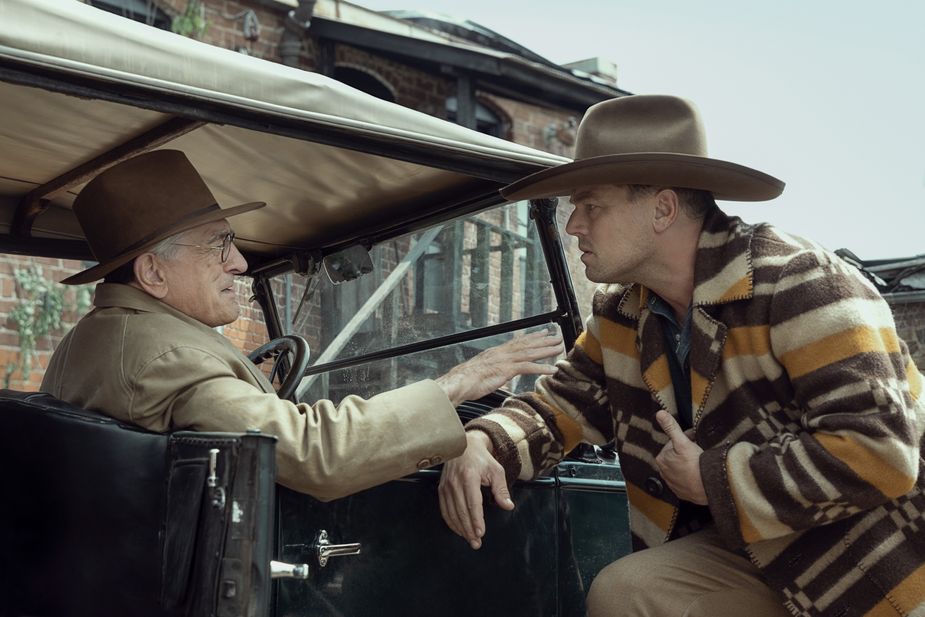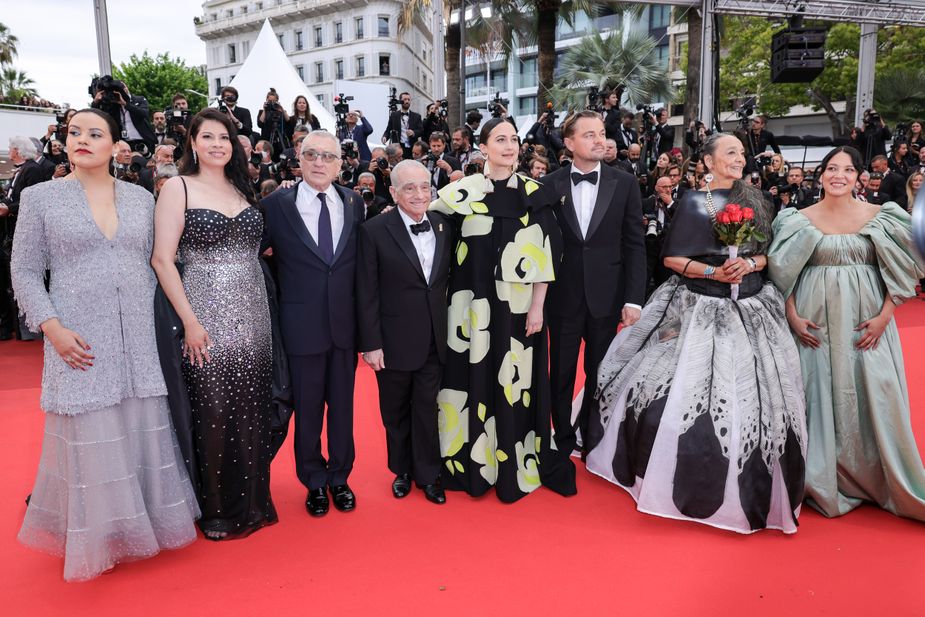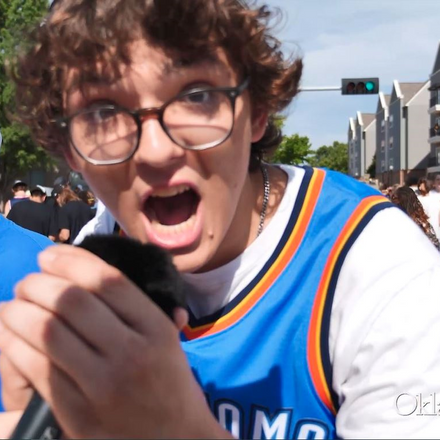Moonlight on the Osage
Published December 2023
By Mason Whitehorn Powell | 25 min read
Project Gray Horse, the working title for Martin Scorsese’s Killers of the Flower Moon, was well underway by August 10, 2021. On that day, inside an abandoned church in Pawhuska, hundreds of crew members were scrambling past wires and partitions, while extras marched in and out of the stifling Oklahoma heat. Between takes, actors Jesse Plemons and Tatanka Means hung around as western-attired FBI agents. Brendan Fraser was making his comeback opposite John Lithgow as lawyers on opposing sides. The church had been converted into a federal district courthouse with a judge’s bench where an altar once stood. Roughly half of the courtroom gallery was filled with Osages in traditional clothing. Scorsese directed the scene by monitor with executive producer Marianne Bower by his side. Crew rearranged lighting and camera angles for hours, continually shooting just minutes of footage blocked that day. Scorsese was shaping the complex layers of this reality into a moment in 1926, when William “Bill” K. Hale was on trial for murdering Osage Indians. He was telling our story.

Lily Gladstone and Robert DeNiro between takes on the set of Killers of the Flower Moon. Photo courtesy Apple
Suddenly feeling like a trial reporter, I watched a man who looked like Leonardo DiCaprio transform into Ernest Burkhart on the witness stand, and I was filled with terror. He perfected guilt, channeling it through his bones, clenched jaw, and sour eyes. His uncle Bill Hale was evil, and like the devil, he was fighting for Ernest’s soul. Would truth remain hidden in the penitent heart of one man, or would he confess his sins before the law and God? Could there be justice for a tribe that had nearly been decimated by the same sovereignty that now was defending them? Somehow, this moment felt like an acquittal of the actual past, the murders, the Reign of Terror that washed across The Osage in a flood of blood and oil money a century ago.
“How can we go deeper, how can we see more clearly, how can we express this constant tension between great good and great evil that we live with every day of our lives?” asked Scorsese rhetorically in our email interview.
As an enrolled tribal member who grew up in Osage County, I know this question still is prevalent in the place these acts were committed. Maybe the only way to see yourself, your people, history, and home is through another’s eyes. What isn’t shown on screen is the close relationship Scorsese developed with Osage people to, as he says, “hear the stories, to understand the suffering and the tragedy they endured, and most important of all—to feel the resilience.” Beyond that, he says, he wants everyone “to know the Osage Nation, period.”

Leonardo DiCaprio, Lily Gladstone, Martin Scorsese, and Robert De Niro on the Osage County set of Killers of the Flower Moon. Photo courtesy Apple
There was a whole lot of hoopla in small town Oklahoma on April 19, 2021, when Scorsese began shooting his twenty-seventh film, an adaptation of David Grann’s nonfiction bestseller Killers of the Flower Moon: The Osage Murders and the Birth of the FBI. DiCaprio was attached to the project even before the release of Grann’s book, and as a producer, he ensured Killers moved forward despite pandemic delays. As an actor, he startled studio executives and fans when he opted to play a villain alongside fellow longtime Scorsese collaborator Robert De Niro, who plays Hale. By 2021, Apple Studios had allocated more than $200 million for Project Gray Horse, generating a noticeable social and economic splash. The Bartlesville Development Authority estimates the film’s impact on the region’s economy at more than $40 million. The film humanizes Grann’s source material, depicting one of the darkest chapters of American history through relationships, devil’s handshakes, and a community under attack.
“I grew up with people like Frank and Russell in The Irishman and like Ernest and Bill in Killers. They committed horrifying acts, and they were human beings. They had souls,” says Scorsese. “That’s an extremely uncomfortable fact of humanity that a lot of people just don’t want to deal with. With Killers, we were dealing with that vast mentality, these lies that white people told themselves that gave them the license to swoop in, assume authority, and frame everything in racist terms. The worst of them insinuated themselves into the community and stole vast sums of money and valuable land rights and murdered hundreds of Osage. And it is a story that was swept under the rug—that’s why the book came as a shock to so many people. And for me, the biggest consideration was to get the story absolutely right from an Osage perspective.”
At the center of the story, Blackfeet and Nimíipuu actor Lily Gladstone plays Mollie Burkhart (née Kyle), an Osage woman who married Ernest Burkhart in 1917. Burkhart was the nephew of Hale, the “King of the Osage Hills,” a wealthy rancher, banker, and businessman who settled on the Osage Reservation around 1900. Like many during this period in Osage history, he built his empire and reputation upon entrepreneurial schemes that capitalized on Osage wealth and land—schemes that transformed his business into a secret criminal enterprise of murder for profit.
The adage that truth is stranger than fiction applies here, as Osage people faced unique circumstances among Natives in Oklahoma. The boundary line of Osage County contains 1.47 million acres purchased from the Cherokees for a little more than a million dollars in 1883, eleven years after the Osage had been relocated there. This land became the Osage Reservation, held in trust by the government with title possessed communally by Osages. But forced removal took its toll, and harsh winters, disease, and governmental mismanagement of annuity payments and food distribution caused the tribal population to shrink by more than 50 percent, leaving just 2,229 surviving tribal members in 1906.
That year, the Osage Tribe Allotment Act of Congress divided the land and distributed it to individual title-holding members of the tribe—just one of the federally backed land-grab plans of the era. But in negotiations, Osage Chief James Bigheart ensured that communal subsurface mineral rights were legally bound to reservation land. This established what became known as the headright system, where oil production within the county triggered quarterly distributions of royalty payments to the 2,229 original Osage allottees and their descendants in perpetuity.
Almost overnight, the Osage people became the richest population in the world per capita, which was a balm to recent hardships and their forced displacement. The U.S. government took notice, refusing Osages access to their wealth except through white guardians, executors who managed these funds on their behalf. But money rolled in nonetheless: The finest cars and clothes came from overseas, Osage families had drivers and servants, and they invested in education, even sending students to prestigious universities.
News of Osage wealth spread, often racially framed in national newspapers as grotesque and unpuritanical, and hordes of white settlers arrived to work in oil, ranching, trading, or industries like insurance, hotels, or entertainment. A black market also emerged in parallel, beset by bootlegging, wrangling, price gouging, and other Wild West-style criminality.
.jpg)
Newspapers around the state—and country—reported on the Osage Reign of Terror and subsequent arrests and trials of William K. Hale, Ernest Burkhart, and others in 1926. Image courtesy Oklahoma Historical Society
Chief Bigheart knew unscrupulous whites would arrive and attempt to thwart the Osages’ new prosperity by taking land and headrights, which is why he advocated for a mineral estate during the allotment period. In 1904, he traveled to Washington, D.C., to lobby for the estate with Osage tribal council member (and later chief) Fred Lookout, but before voting on the bill took place, he was attacked and beaten to paralysis. It took him four years to die from his injuries.
His son, George Bigheart, allegedly drank poisoned whiskey in 1923 and was put on a train to an Oklahoma City hospital by Burkhart and Hale. There, he summoned his attorney W.W. Vaughan, but died shortly after they spoke. Vaughan was shot in the head and thrown from a train on his return to Pawhuska. The extent of crimes committed against Osages and their supporters reaches far beyond Grann’s book and Scorsese’s film. During this period, the Osages’ money became a tool of their oppression. The story of the conception, execution, and investigation of these crimes—and the psychological torture of Osages—forms the narrative backbone of Killers of the Flower Moon.

Crews transformed downtown Pawhuska into 1920s Fairfax, a town that still exists about a half-hour's drive from the filming location. Photo courtesy Melinda Sue Gordon and Apple
In an odd twist of fate, spring and summer 2021 saw downtown Pawhuska become a living movie set that reflected Fairfax and the unincorporated Osage town of Grayhorse as they stood a century ago. Old cars and horses traversed brick streets that had been covered with dirt. A train station, funeral parlor, and mercantile shops were resurrected from the remains of Pawhuska’s former glory, in the days before the oil money dried up and the circumstances of the Osage and townsfolk changed.
“You’ve got to be tough to survive in this place,” says Geoffrey Standing Bear, principal chief of the Osage Nation. “So that’s the main thing: to be able to take care of our people the way they need to be taken care of. I think we’re just looking at that health issue right now. That’s the immediate, on-top-of-us realization, and it’s getting worse.”
Standing Bear’s concerns as a leader regard the disproportionate health and life expectancy issues Native American communities face compared to similarly situated minority populations. He cites an internal report by the previous tribal administration that found the life expectancy of an Osage who lived in Pawhuska was ten years less than one who lived in Tulsa—just a distance of about fifty miles. His efforts to improve community health include elderly care, a universal health benefits programs, and the construction of a local drug treatment center.
The widespread telling of the Killers story may help catalyze change. Standing Bear is confident in the preservation of Osage culture, mentioning the collaboration of Christopher Cote and June Carpenter as Osage language coaches for Native and non-Native actors on the film. And as principal chief, he ensured the filmmakers worked with Osages to get the job done right, appointing the late elder John “Johnny” W. Williams Sr. as an on-set advisor and Chad Renfro and Addie Roanhorse as ambassadors who worked closely with the production. Now, he even meets with Apple CEO Tim Cook to discuss possible education programs and future endeavors.
Scorsese was reviving the past—to the annoyance of some locals, who scoffed at the Hollywood of it all. But Scorsese’s efforts are apparent not only in traditional Osage costuming and use of the Osage language but in ceremonies and events that almost every living Osage has seen only in photos or heard about in stories.
Yancey Red Corn depicts sitting Osage Chief Arthur Bonnicastle in the film. Bonnicastle allegedly fell off a train in 1923 while returning home from Washington, D.C. His contemporary and predecessor, Chief Paul Red Eagle, appears throughout and is played by Everett Waller, the Osage Nation Minerals Council chairman. Scorsese heard Waller talking during a break in filming and, according to Waller, “He just took the script out of my hand and said, ‘Can you do that again?’”
These figures’ big moment in the film arrives at a tipping point, the emotional climax where Osages take matters into their own hands diplomatically, while local and state officials refuse to investigate the murders. Waller’s words reveal ancestral knowledge that speaks to something greater than himself. His extemporaneous speech addresses the past and present simultaneously: Work by the current Minerals Council is simply a continuation of the critical events James Bigheart helped set in motion, and before him, the concurrent war chiefs Pawhuska (White Hair in Osage), Black Dog, Claremore, and their advisor Wah-tian-kah—all of whom led the Osage people out of the 1700s and towards the home we have today.
“It’s the mentality that no one’s going to come to our reservation to push us around. No one’s going to do that to my children or grandchildren. These folks fought and died for this acreage. We weren’t monsters. We were just feeding our group,” Waller says. “We prayed for life, that Wahzhazhe way of life, that we could keep it somehow. The FBI weren’t our saviors. We forced them to come here.”
But fallout from the Reign of Terror still is evident. A $380 million settlement was levied against the government for mismanagement of the Osage Minerals Estate in 2011. In 2014, another case invalidated several Osage County oil leases under the National Environmental Policy Act—as a result, the Superintendent of the Osage Agency of the Bureau of Indian Affairs rewrote drilling requirements to make them prohibitively strict, preventing most new projects from getting approved. Today, of the original 2,229 full headrights, 1,744 portions of headrights currently belong to individuals, institutions, and religious organizations unaffiliated with the tribe, issues reported in detail by Rachel Adams-Heard and Allison Herrera in the 2022 podcast In Trust. In 1978, Congress prohibited the Secretary of the Interior from allowing non-Osages to inherit or otherwise obtain shares of the tribal estate. The reduction in headright payments—and the families who lost theirs altogether—has had endemic effects in these communities.

Robert De Niro and Leonardo DiCaprio on the set of Killers of the Flower Moon. Photo courtesy Apple
But they are communities worth getting to know. The three Osage districts are Pawhuska (Wa-Xa-Ko-Li’n), Hominy (Zon-Zo-Li’n), and Grayhorse (Pah-Sue-Li’n). They form a rough triangle spread across the county, with Pawhuska as the seat of Osage governance. The tribal complex includes government buildings, election grounds, and the Osage Nation Museum, all of which sit atop a hill overlooking downtown.
Hominy, like each district, has an Indian Village with a council, where the tribe manages properties. In the villages are three dance arbors and community buildings for the annual I’n-Lon-Schka dances in June. The Grayhorse village is quaint and rural, featuring classic Osage homes with large porches and outdoor platforms where families prepare for the dances or share community meals together. While Hominy and Pawhuska are more or less contiguous with the townships that share their names, Grayhorse is more remote and untouched by time. It’s also where the Burkhart family lived and where much of the film takes place.
The story of the Reign of Terror reveals the duality Indigenous people experience as both Natives and Americans. The legacy of the Osage is visible throughout the film in small gestures and traditions that will resonate with audiences. One of Oklahoma’s most valuable cultural resources is the preservation and longevity of its Indigenous peoples.
Osage culture is not built on the promise of oil—it survives in a spirit of generosity and dignity, in the beauty of our lands and a desire to be educated and worldly. This reveals a creativity that has allowed us to adapt to the world we inherited. It’s an idea expressed in the works of Osage writers like John Joseph Mathews, Louis Burns, and Charles H. Red Corn. It’s the essence of Killers of the Flower Moon.
“My hope is the film raises awareness about every aspect of the story, its lasting effects, and the greater story of the Osage Nation,” Scorsese says. “As far as initiating actual change, all I can say is that it would be a welcome development.”
No one knows how the film’s impact will affect the tribe, but respectful exchange is welcome. Fairfax and Grayhorse are not popular travel destinations, and to visit them without context would be to miss out on the characteristic elements of these communities and what the tribe has to offer today. Those who wish to engage with Osage culture can visit the White Hair Memorial between Hominy and Grayhorse, stop at the Osage Nation Visitors Center, Osage Nation Museum, Big Rain Gallery, and The Water Bird Gallery in Pawhuska.
Marianne Bower, an executive producer and Scorsese’s right hand on the film, visited my late grandfather, Dudley Whitehorn, at his home surrounded by his family. We cooked her dinner, shared stories, and presented her with a blanket, as is our custom.
Years ago in the same room, my grandfather had performed an Osage naming ceremony for my cousins and myself. He inherited Deer Clan naming rights from his aunt, Magella Whitehorn. She was alive during the Reign of Terror and blind from a young age, but her driver took her around the county in slick cars, and she maintained her own home and property. As a child, she was forced to attend boarding school where she experienced abuse and was forbidden from speaking Osage. Later, when the Osage Council decided to leave the old ways behind—our original spiritual practice and sacred belief system—she mourned this loss.
Chief Standing Bear recalled the Little Old Men, the Ne ke a Shin ka. In the past, he had inquired why the Osage spiritual leaders were called little when they had been recorded as reaching seven feet tall. He suggested Magella Whitehorn would say, “You’re not thinking Osage.” In this context, little meant humble. It designated our place in the universe.
Suddenly, the past coalesces in relationships and stories, whether it be by lineage or watching a movie. Bower, Scorsese, and many others worked hard to realize this vision—to make a film that honored Osages by building mutual respect with the community. They listened.

The film recieved a nine-minute standing ovation when it premiered at the Cannes Film Festival in May of this year. Here, members of the cast walk the event's red carpet. Photo courtesy Dave Bennett
The film will bring no one back, but it might absolve us from a century of silence that would obfuscate the difficulties of the present. The grand courtroom and fake jail cell in the church basement were deconstructed when filming wrapped on September 15, 2021. But I wondered what would become of us, reliving this a hundred years later, and I understood that not enough has changed, and many good, beautiful things have stayed the same.
Past the old brick church that was filled with stardom, beyond city limits, you can stand among the silence of the prairie as tallgrass begins to sway. Stillness gives way to the rustle of blackjacks, the song of the meadowlark, and coyotes who still call out across the night. This is The Osage: transitory and eternal. As long as this land exists, our memory will be carried forward by the seasons that used to guide us and the prayers we once shouted at the dawn.
Killers of the Flower Moon is now streaming on Apple TV+.
**







